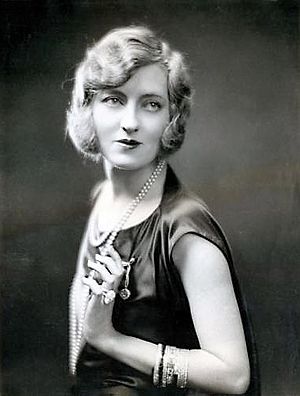Peggy Hopkins Joyce facts for kids
Quick facts for kids
Peggy Hopkins Joyce
|
|
|---|---|
 |
|
| Born |
Marguerite Upton
May 26, 1893 Berkley, Virginia, U.S.
|
| Died | June 12, 1957 (aged 64) New York City, U.S.
|
| Resting place | Gate of Heaven Cemetery |
| Education | The Chevy Chase School for Girls |
| Occupation | Actress, artist model, dancer |
| Years active | 1916–1926 |
| Spouse(s) |
Everett Archer, Jr.
(m. 1910–1910)Sherburne Hopkins
(m. 1913; div. 1920)J. Stanley Joyce
(m. 1920; div. 1921)Gustave Morner
(m. 1924; div. 1926)Anthony Easton (m. 1945; div. ?) Andrew Meyer
(m. 1953) |
Peggy Hopkins Joyce (born Marguerite Upton; May 26, 1893 – June 12, 1957) was an American actress, artist's model, and dancer. She was famous for her exciting life, which included many marriages to wealthy men. Peggy was also known for her large collection of diamonds and furs, and for living a very fancy lifestyle.
Contents
Early Life and First Marriages
Peggy Hopkins Joyce was born Marguerite Upton in 1893 in Berkley, Virginia. When she was 15, she left home. On a train trip, she met a rich man named Everett Archer Jr. She married him in 1910.
However, this marriage ended after six months because Peggy was underage. She later said that being a millionaire's wife was "not at all what I thought it would be." With money she received, Peggy went to a private school in Washington D.C. There, she met Sherburne Hopkins, a lawyer from a wealthy family. They married on September 1, 1913, when she was 20 years old.
In 1917, Peggy moved to New York City to start a career in show business. She and Sherburne Hopkins divorced in January 1920.
Becoming a Star and Public Figure
Peggy Joyce made her first appearance on Broadway in 1917 in a show called Ziegfeld Follies. She also appeared in another show called A Sleepless Night.
In 1920, she married her third husband, J. Stanley Joyce, who was a rich lumberman. She then became known as Peggy Hopkins Joyce. She made headlines for spending a lot of money, including a $1 million shopping spree in just one week!
By 1922, Peggy's life and many marriages made her one of the most talked-about women in American newspapers. She would often give interviews. Famous people like Cole Porter and Irving Berlin even used her name in their songs. Comedians like Will Rogers would make jokes about her.
Her fame grew even more when she performed in The Earl Carroll Vanities in 1923. She also appeared in her second film, The Skyrocket (1926). This movie caused some debate about film censorship. In 1930, Peggy published a book called Men, Marriage and Me. It was said to be based on her personal diary.
In 1933, Peggy Joyce played herself in the movie International House. The film even made some friendly jokes about her love life.
Peggy Joyce once owned a very famous jewel called the Portuguese Diamond. It is one of the most expensive diamonds in the world. She sold it to Harry Winston, and it is now shown at the Smithsonian Institution in Washington, D.C.
Some people thought Peggy couldn't read or write, but she wrote a column in the early 1930s for a New York publication called Varieties. In her column, she shared interesting stories about famous people in New York and London.
Her Many Marriages
Peggy Joyce was married six times. Her first marriage was to Everett Archer Jr. in 1910, which was ended because she was underage. Her second marriage was to Sherburne Hopkins in 1913.
In 1919, she met J. Stanley Joyce, a wealthy lumberman. He helped her get a divorce from Hopkins. Two days after her divorce was final, on January 23, Peggy and Stanley got married.
Their divorce in 1921 was very public. During the trial, it was revealed that J. Stanley had given Peggy a lot of valuable things, including jewelry worth $1.4 million and a $300,000 home. Peggy received $600,000 in the divorce settlement. She also kept all the jewelry she had received and got money each month for life.
After her third divorce, Peggy said she would never marry again. However, she continued to date many wealthy men.
Despite her promise, Peggy married Swedish Count Gösta Mörner on June 3, 1924. She told the press that this was her first true love. But by the end of July 1924, Peggy decided to go back to her career and left Count Mörner. They divorced in February 1926.
Peggy remained single for the next nineteen years. In the early 1930s, she had a relationship with Walter Chrysler, who was a famous car maker. He reportedly gave her $2 million in jewelry and two expensive cars. Later, she had a relationship with a British professor named Charles Vivian Jackson. He died in an accident in 1937. Peggy later said he was "the only man I ever loved."
On December 3, 1945, Peggy married for the fifth time to an engineer named Anthony Easton. This marriage made news because Peggy refused to say the word "obey" in her wedding vows. This marriage ended sometime before 1953.
In 1953, Peggy married for the sixth and final time to Andrew C. Meyer. He was a retired bank official. They stayed married until Peggy's death in 1957.
Later Years and Passing
After marrying her sixth husband in 1953, Peggy Joyce moved to Woodbury, Connecticut. She lived there for her remaining years. On June 1, 1957, she was admitted to a hospital in New York City after being diagnosed with throat cancer. Peggy Joyce passed away on June 12, 1957, at the age of 64.
She is buried at Gate of Heaven Cemetery in Hawthorne, New York.
Selected Films
- The Turmoil (1916)
- The Skyrocket (1926)
- International House (1933)
Images for kids
See also
 In Spanish: Peggy Hopkins Joyce para niños
In Spanish: Peggy Hopkins Joyce para niños



